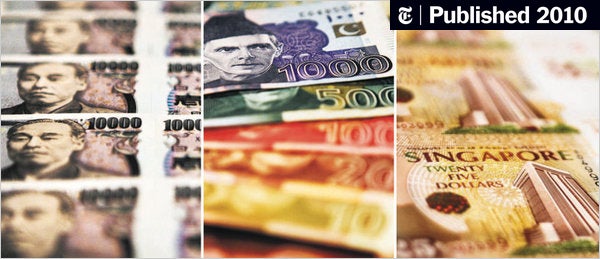
WHILE the long-term outlook for the dollar seems to be dismal these days, what about other currencies? And if you are interested in investing in currencies, how best to go about it?
It’s possible not only to invest in a basket of foreign currencies. but to make one-way bets on individual currencies. Animated by the Australian dollar? Riveted by India’s rupee? More than 40 ways are available to wager on the direction of currencies in the $4 trillion global currency market, which is roughly four times as large as the United States bond market.
Always remember that the currency markets are notoriously volatile, so timing the market is difficult and risky. Despite all of the cable TV ads promoting software that can produce foreign-exchange trading profits, even the largest financial institutions get burned trading currencies.
You need to consider carefully which, if any, investment vehicle is suitable for you. The choices include at least 14 mutual funds, 19 exchange-traded funds and 10 exchange-traded notes issued by banks that are all based on currency strategies.
If you want exposure to foreign currencies to blunt the impact of a portfolio largely dominated in dollars, a large basket of currencies managed by a mutual fund might be suitable. Experts say it depends on the portfolio you are trying to hedge.
“I don’t like currency baskets,” said Michael Dubis, a certified financial planner based in Madison, Wis. He said such investments were often “expensive, unnecessary and will already overallocate currency, which is already embedded in your international stock exposure. And thinking one knows the direction of currency shifts is insanely delusional.”
Or do you have a strong hunch about where the dollar is headed? For bears, the Rydex Weakening Dollar 2x Strategy A (RYWBX) fund uses leverage to double your returns on a falling dollar. The company has another fund (RYSJX) that bets on the dollar strengthening. The Merk Hard Currency fund (MERKX) invests in gold (which rises in price when the dollar falls) and a group of major currencies to wager against the dollar.
What if you have a time-sensitive transaction or heavy exposure to another currency and want to ensure that you don’t lose money if it appreciates relative to the dollar? A more complex instrument called a currency forward might be suitable. It’s a contract that locks in a price to buy or sell a specific quantity of the currency at a future date.
Or maybe you’re just plain skittish about the prospects of the dollar as Congress continues to sell Treasury securities in a weakened economy to finance the more than $13 trillion national debt. That’s a reasonable concern, and if most of your investments are in dollars, you may be able to realize some gains in stocks and bonds denominated in other currencies.
Alec Young, international equity strategist for Standard & Poor’s, said that for investors in the United States, “currency diversification is a key benefit of international investing; you can make a case for the dollar being in a secular decline.”
As with the stock market, though, currencies don’t follow a script. The Greek debt crisis brought on a 15 percent decline in the euro against the dollar earlier this year, although the euro has recovered more than 10 percent since then.
From a financial planning perspective, rather than placing your bets on a particular currency or strategy, you’d be better off focusing on growth from foreign stocks. If you happen to benefit from currency movements, it’s an added benefit though it carries the risk, of course, that the currency will move the other way. And don’t forget that many American multinationals have a large foreign presence that could promise capital appreciation from overseas.
Focusing on currency strategies can also be expensive. The Merk fund, for example, charges 1.3 percent annually in expenses to manage a handful of currencies. Compare that with 0.27 percent for the Vanguard Total International Stock Index fund, which holds more than 1,800 stocks in developed and emerging markets.
A more pressing concern for American investors and one that may be clouded by the foreign exchange investing frenzy is domestic inflation and interest rate risk. When interest rates rise, bond prices fall and you lose purchasing power. While that doesn’t appear to be a problem now, it may be when the United States economy heats up.
Rick Miller, a financial planner with Sensible Financial in Waltham, Mass., recommended that investors protect against purchasing power erosion with Treasury inflation-protected securities, or TIPS. They are also sold through the Treasury in the form of I-Bonds. Unlike most bonds, TIPS keep pace with the Consumer Price Index and increase in value when inflation climbs. The securities are available in mutual funds like the Vanguard Inflation-Protected Securities fund (VIPSX) and the iShares Barclays TIPS fund (TIP).
“TIPS are boring,” Mr. Miller said, “but they are better than stocks or commodities, which could go down with inflation.”
A tunnel-vision focus on whether the dollar will continue to slide may distract you from globally diversifying your portfolio in foreign stocks and bonds. Only about 42 percent of the world’s free-floating stock market value is in American stocks. Broad-based international stock and bond funds include the iShares All Country World Index exchange-traded fund (ACWI) and the Pimco Foreign Bond fund (PFUIX).
So if you’re ignoring Europe, South America and developing countries, you could be missing out on growth. It’s far more likely that you’ll make money in a passive portfolio covering dozens of countries than making one bet on a single currency.


